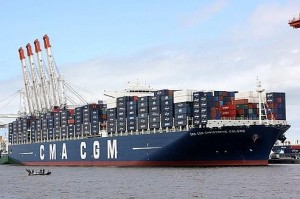
(AFP File Photo)
The government has begun taking steps to convert Egypt into a global logistics centre for the handling and storage of grain and food commodities according to Prime Minister Ibrahim Mehleb. Damietta has been identified as the first site in which logistics operations will begin.
Ministers of Planning and Supply will be responsible for working on integrated studies for the project, announced Mehleb, adding: “This is a large national project that is no less important than the Suez Canal project.”
According to a cabinet statement, Mehleb pointed out that the total area for the proposed project is 3.35m square metres, of which 0.56m fall within the boundaries of the Damietta Port. The remaining 2.79m square metres comprise a portion of the untapped industrial area northeast of the port and is owned by the New Urban Communities Authority.
Mehleb added that the project includes re-planning for the grain area within the port and its division into a separate, integrated station. The storage area will be expanded and connected with a road bridge for vehicles, and conveyor belt lines in the industrial area, medium-term storage for the proposed East port, and a wall, gates, infrastructure, and facilities for the industrial and storage zone will all be constructed. The area will fall under the jurisdiction of the customs area at Damietta Port in order for logistic, manufacturing, and storage activities to be practiced within the Customs Office.
The Ministry of Supply said that the project includes the addition of two sea piers 650-700 metres in length and 17 metres deep to receive large ships carrying up to 150,000 tonnes of grain. A river pier 1,200 metres long and 5-6 metres deep will also be added with all relevant equipment. The project provides for the construction of modern silos and domes for storage in three storage areas with a capacity of 7.5m tonnes. This project will serve to quadruple the capacity of Egypt’s ports from 2.5m tonnes to 10m tonnes.
The ministry also confirmed that the project is built using advanced technology systems to connect all its marine, storage, and industrial parts with belts to transfer grains and modern equipment that will not require frequent transfer, lower costs, and carry out internal trading at a rate of at least 16,000 tonnes/hour. These rates will lead to great savings compared to the traditional method of moving, storing, and manufacturing grains. The project also includes a complete electronic system for surveying, monitoring, and managing marine operations, freight, allocation, inspection, and customs clearance.
He also clarified that the project covers the construction of five investment and industrial zones for grains and food commodities with a total land use of 1.7m metres. The first area will be an industrial zone for mills and for producing fine flour for local consumption and export. The second industrial zone will be for manufacturing soy, and provides for food commodity manufacturing, oil extraction and pasture production.
The third zone will be allocated to corn production and covers oil, starch, and fructose extraction, while the fourth zone will be dedicated to distilling and packaging sugar. The fifth zone will be designated to complementary industries based on the abovementioned industries, including macaroni, pastries, burgers, and various food industries as well as pastures.
The Minister of Supply also noted that the total amount of trade expected for the multimedia transportation systems for the project is around 65m tonnes/year. The project will increase the capacity of annual marine trading of grains and food commodities in Damietta port from the current 7-8m tonnes to 40m tonnes, 12m tonnes of which will be re-exported locally.




